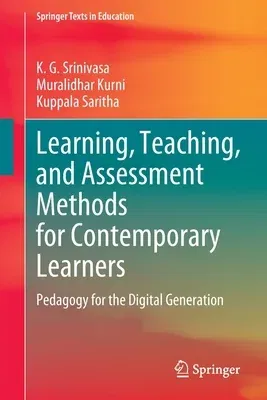Chapter 1. Introduction 1.1. What is Pedagogy? 1.2. Why Pedagogy is
Important? 1.3. Different Types of Pedagogies 1.4. How is Pedagogy
Changing? 1.5. How does pedagogy impact the learner? 1.6. Modern
learning, teaching, and assessment methods 1.6.1. Crossover Learning
1.6.2. Learning Through Collaborative Argumentation 1.6.3. Incidental
Learning 1.6.4. Context-Based Learning 1.6.5. Computational Thinking
1.6.6. Learning by Doing 1.6.7. Embodied Learning 1.6.8. Adaptive
Teaching/Learning 1.6.9. Analytics of Emotions 1.6.10. Stealth
AssessmentChapter 2. Crossover Learning 2.1. What is Crossover Learning?
2.2. Why is it good to implement? 2.3. Why is Crossover Learning Working
in the Classroom? 2.4. How to implement it? 2.5. Limitations / Major
Barriers and Disadvantages of adopting Crossover Learning 2.6. Case
Studies
Chapter 3. Learning Through Collaborative Argumentation 3.1. What is
Collaborative Argumentation? 3.2. Benefits of Argumentation 3.3.
Techniques for Effective Collaborative Argumentation 3.4. Preparing
Classroom Environments for Collaborative Argumentation 3.5. Case
Studies
Chapter 4. Incidental Learning 4.1. What is Incidental Learning? 4.2.
What is the Impact of Incidental Learning? 4.3. How to Engage with
Incidental Teaching? 4.4. Incidental Learning in the Classroom 4.5.
Incidental Learning and Intentional Learning 4.6. Informal and
Intentional Learning 4.7. Case Studies
Chapter 5. Context-Based Learning 5.1. What is Context-Based Learning?
5.2. Why Context-Based Learning? 5.3. Context-Based Learning and
Competence 5.4. Impact on Students' Learning 5.5. Creating Context-Based
Learning Environments 5.6. Connecting Concepts and Contexts 5.7.
Selection of Contexts 5.8. Assessment in context-based teaching and
learning 5.9. Case Studies
Chapter 6. Computational Thinking 6.1. What is Computational Thinking?
6.2. Why Computational Thinking is important? 6.3. Key Skills for
Computational thinking 6.4. Six Principles of Computational Thinking
6.5. Learning Strategies for Developing Computational Thinking Skills
6.6. Computational thinking in practice 6.7. Thinking computationally
6.8. Assessment of computational thinking 6.9. Case Studies
Chapter 7. Learning by Doing 7.1. What is Learning-by-doing? 7.2. Why
Learning-by-doing is important? / Why is Learning-by-doing effective?
7.3. What We Learn When We Learn by Doing

